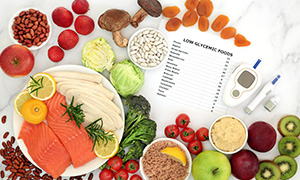
You’re probably very familiar with how blood sugar can impact your mood and energy. Cast your mind back to when you last indulged in something sweet. For a few moments, you may experience a sugary high. The next, you crash. And with that comes lethargy, irritability, and more cravings.
Aside from short-term shakiness, lack of focus, and mood swings, chronically imbalanced blood sugar levels can have a long-term effect on your health and happiness. It’s a rollercoaster you don’t want to be on.
Although sleep, stress, exercise, and genetics are important pieces of the puzzle, a good diet remains the cornerstone of good blood sugar control. Here, we take a look at how food choices help support energy levels, better mood, and steadier blood sugar levels.
What is blood sugar?
Blood sugar typically refers to the level of glucose that circulates in your blood. And this is mainly determined by the foods you eat. When you consume meals or foods containing carbohydrates, they’re broken down into very simple molecules called glucose. This means you’ll experience a spike in circulating blood sugar – which returns to baseline hours later – every time you eat them. Given how many meals and snacks we consume on a daily basis, our blood sugar levels oscillate constantly.

What are the symptoms of blood sugar imbalance?
Blood sugar imbalance is very much like riding a ‘glucose roller-coaster’: you’ll experience food cravings, become hungry very quickly after a meal (within 90 minutes), and notice energy dips throughout the day. If you stay on this rollercoaster long enough, you may encounter hormonal dysfunction (PCOS), acne, poor sleep, weight gain, mood changes, and even type 2 diabetes.
What does healthy blood glucose management look like?
You shouldn’t aim for a completely flat blood sugar level trajectory. Healthy blood sugar management simply means smoothing out any glucose curves and minimising the dips. Fewer cravings signal good blood sugar management. We all get cravings – and it’s nothing to feel ashamed about. But balancing glucose levels will help reduce those all-consuming, uncontrollable hankerings that many of us our prone to.
Dietary interventions to manage blood sugar levels
Changing what and how you eat is one of the best ways to manage your blood sugar levels. Smoother glucose curves mean you’ll be on the road to increased energy, fewer cravings, better hormonal regulation, improved mental health, clearer skin, and better overall wellbeing.
Pass on the bread basket
Starting a meal with starch will lead to a glucose spike, followed by a crash later on, which will only intensify food cravings. So, as difficult as it is – especially if you’re in a restaurant and they place a delicious doughy bounty under your nose – try to avoid eating bread before anything else. And if you want to enjoy some with your meal, just eat it last.
Think carefully about breakfast
How you choose to break your fast will influence what kind of day you have. A balanced breakfast will set you up in an energised, positive way, making you want to high-five everyone you meet; a not-so-balanced one will set you on a path of fatigue, irritability, and cravings.
Go savoury
Protein: Eggs, Greek yoghurt, tofu, smoked salmon, or protein powder
Fat: Nuts, seeds, nut butter, avocado, butter, or extra virgin olive oil
Fibre: Any vegetable, seeds, or nuts Starch
(optional): 100% wholegrain rolled oats, rye bread, pumpernickel bread, or sourdough bread Whole fruit (optional): Blueberries, strawberries, raspberries, blackberries, or apples

Blood-sugar-balancing breakfast ideas
• Scrambled eggs with spinach, mushrooms and tomatoes on rye toast
• Peanut butter chia seed overnight 100% wholegrain rolled oats
• Roasted chickpeas and avocado on sourdough toast
Be careful with oats
Newsflash: instant or rolled oats are actually very processed, meaning they spike your blood glucose levels, which isn’t great first-thing in the morning. If you enjoy porridge, always use traditional 100% wholegrain rolled oats, and pair them with fibre (nuts or chia seeds), protein and fat (nut butter or Greek yoghurt), and low-sugar fruit (berries).

Eat your fruit at the end
Even though whole fruit is rich in fibre – which slows down glucose spikes – it still contains sugar. If you’re looking for something sweet in the morning, try to have any fruit at the end of your breakfast to reduce its impact on your blood sugar.
Pass on the OJ
Breakfast and orange juice go together like peas and carrots. And, on the surface, orange juice seems like a healthy choice. It contains vitamins and antioxidants, right? Yes, in part. But the problem is that OJ lacks fibre, which is important for blood sugar regulation, so it’s best to avoid it in the morning.
The more complex the carb, the better
Healthy, complex carbs, like whole grains (quinoa, buckwheat, and whole-wheat pasta), fibre-rich veggies (carrots, leafy greens, and cauliflower), fibre-rich fruit (berries and apples), and beans are much better for your blood sugar because they contain fibre, which helps to slow down the spike in glucose.
Sneaky simple carbs to watch
• Processed foods
• ‘Beige foods’ (white pasta, white bread, white rice)
• Breakfast cereal
• Sweets
Fabulous fibre
Combing carbs with fibre means the glucose from the starchy food won’t hit your bloodstream as quickly, resulting in a smaller spike. Instead of reaching for plain bread – guaranteed to spike your blood sugar immediately and lead to an energy crash – why not enjoy it with some protein-dense hummus and fibre-rich avocado?
Rethink your sugar intake
The body breaks sugars down very easily, causing an almost immediate spike in blood sugar. Studies show that excessive sugar consumption is associated with developing insulin resistance and type 2 diabetes (2). Weaning yourself off sugar is hard, but reducing your intake is one of the best things you can do for your health.

Go for low-GI (glycaemic index) foods
The GI is a rating system that measures how quickly carbohydrate-containing foods affect your blood sugar level when eaten on their own. Low-GI foods tend to break down more slowly, meaning they’re less likely to cause a rapid increase in blood sugar levels. High-GI foods, on the other hand, are broken down quickly and lead to an almost immediate spike in glucose.




